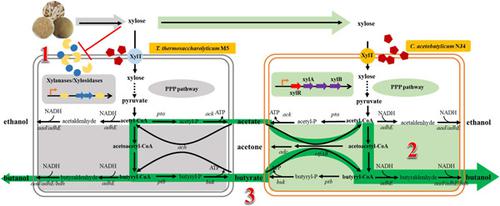当前位置:
X-MOL 学术
›
Biotechnol. Bioeng.
›
论文详情
Our official English website, www.x-mol.net, welcomes your feedback! (Note: you will need to create a separate account there.)
Consolidated bioprocessing performance of a two-species microbial consortium for butanol production from lignocellulosic biomass.
Biotechnology and Bioengineering ( IF 3.8 ) Pub Date : 2020-06-17 , DOI: 10.1002/bit.27464 Yujia Jiang 1 , Yang Lv 1 , Ruofan Wu 1 , Jiasheng Lu 1 , Weiliang Dong 1, 2 , Jie Zhou 1 , Wenming Zhang 1, 2 , Fengxue Xin 1, 2 , Min Jiang 1, 2
Biotechnology and Bioengineering ( IF 3.8 ) Pub Date : 2020-06-17 , DOI: 10.1002/bit.27464 Yujia Jiang 1 , Yang Lv 1 , Ruofan Wu 1 , Jiasheng Lu 1 , Weiliang Dong 1, 2 , Jie Zhou 1 , Wenming Zhang 1, 2 , Fengxue Xin 1, 2 , Min Jiang 1, 2
Affiliation

|
Consolidated bioprocessing (CBP) by using microbial consortium was considered as a promising approach to achieve direct biofuel production from lignocellulose. In this study, the interaction mechanism of microbial consortium consisting of Thermoanaerobacterium thermosaccharolyticum M5 and Clostridium acetobutylicum NJ4 was analyzed, which could achieve efficient butanol production from xylan through CBP. Strain M5 possesses efficient xylan degradation capability, as 19.73 g/L of xylose was accumulated within 50 hr. The efficient xylose utilization capability of partner strain NJ4 could relieve the substrate inhibition to hydrolytic enzymes of xylanase and xylosidase secreted by strain M5. In addition, the earlier solventogenesis of strain NJ4 was observed due to the existence of butyrate generated by strain M5. The mutual interaction of these two strains finally gave 13.28 g/L of butanol from 70 g/L of xylan after process optimization, representing a relatively high butanol production from hemicellulose. Moreover, 7.61 g/L of butanol was generated from untreated corncob via CBP. This successfully constructed microbial consortium exhibits efficient cooperation performance on butanol production from lignocellulose, which could provide a platform for the emerging butanol production from lignocellulose.
中文翻译:

用于从木质纤维素生物质生产丁醇的两种微生物群落的综合生物加工性能。
通过使用微生物聚生体的联合生物加工 (CBP) 被认为是一种从木质纤维素直接生产生物燃料的有前途的方法。本研究探讨了由热解糖热厌氧菌M5 和丙酮丁醇梭菌组成的微生物聚生体的相互作用机制分析了 NJ4,它可以通过 CBP 实现从木聚糖中高效生产丁醇。菌株 M5 具有高效的木聚糖降解能力,因为在 50 小时内积累了 19.73 g/L 的木糖。伙伴菌株NJ4的高效木糖利用能力可以减轻菌株M5分泌的木聚糖酶和木糖苷酶对水解酶的底物抑制作用。此外,由于菌株 M5 产生的丁酸盐的存在,观察到菌株 NJ4 较早的溶剂生成。这两种菌株的相互作用最终在工艺优化后从 70 g/L 的木聚糖中得到 13.28 g/L 的丁醇,这表明半纤维素的丁醇产量相对较高。此外,未经处理的玉米芯通过 CBP 产生了 7.61 g/L 的丁醇。
更新日期:2020-06-17
中文翻译:

用于从木质纤维素生物质生产丁醇的两种微生物群落的综合生物加工性能。
通过使用微生物聚生体的联合生物加工 (CBP) 被认为是一种从木质纤维素直接生产生物燃料的有前途的方法。本研究探讨了由热解糖热厌氧菌M5 和丙酮丁醇梭菌组成的微生物聚生体的相互作用机制分析了 NJ4,它可以通过 CBP 实现从木聚糖中高效生产丁醇。菌株 M5 具有高效的木聚糖降解能力,因为在 50 小时内积累了 19.73 g/L 的木糖。伙伴菌株NJ4的高效木糖利用能力可以减轻菌株M5分泌的木聚糖酶和木糖苷酶对水解酶的底物抑制作用。此外,由于菌株 M5 产生的丁酸盐的存在,观察到菌株 NJ4 较早的溶剂生成。这两种菌株的相互作用最终在工艺优化后从 70 g/L 的木聚糖中得到 13.28 g/L 的丁醇,这表明半纤维素的丁醇产量相对较高。此外,未经处理的玉米芯通过 CBP 产生了 7.61 g/L 的丁醇。


























 京公网安备 11010802027423号
京公网安备 11010802027423号